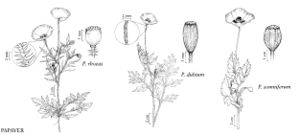Difference between revisions of "Papaver rhoeas"
Sp. Pl. 1: 507. 1753.
FNA>Volume Importer |
FNA>Volume Importer |
||
| Line 27: | Line 27: | ||
}}<!-- | }}<!-- | ||
| − | --><span class="statement" id="st- | + | --><span class="statement" id="st-undefined" data-properties=""><b>Plants </b>to 8 dm, hispid to setulose. <b>Stems</b> simple or usually branching. <b>Leaves</b> to 15 cm; distal often somewhat clustered. <b>Inflorescences</b>: peduncle sparsely to moderately spreading-hispid throughout. <b>Flowers</b>: petals white, pink, orange, or red, often with dark basal spot, to 3.5 cm; anthers bluish; stigmas 5-18, disc ± flat. <b>Capsules</b> sessile or substipitate, turbinate to subglobose, obscurely ribbed, to 2 cm, less than 2 times longer than broad.</span><!-- |
-->{{Treatment/Body | -->{{Treatment/Body | ||
| Line 33: | Line 33: | ||
|habitat=Fields, pastures, stream banks, railroads, roadsides, and other disturbed sites | |habitat=Fields, pastures, stream banks, railroads, roadsides, and other disturbed sites | ||
|elevation=0-2000 m | |elevation=0-2000 m | ||
| − | |distribution=Man.;N.B.;N.S.;Ont.;Que.;Sask.;Alaska;Calif.;Conn.;D.C.;Idaho;Ill.;Iowa;La.;Maine;Md.;Mass.;Mich.;Minn.;Mo.;Mont.;N.H.;N.J.;N.Mex.;N.Y.;N.C.;Ohio;Oreg.;Pa.;R.I.;Tex.;Utah;Vt.;Va.;Wash.;W.Va.;Europe;sw Asia;n Africa | + | |distribution=Man.;N.B.;N.S.;Ont.;Que.;Sask.;Alaska;Calif.;Conn.;D.C.;Idaho;Ill.;Iowa;La.;Maine;Md.;Mass.;Mich.;Minn.;Mo.;Mont.;N.H.;N.J.;N.Mex.;N.Y.;N.C.;Ohio;Oreg.;Pa.;R.I.;Tex.;Utah;Vt.;Va.;Wash.;W.Va.;Europe;sw Asia;n Africa. |
|discussion=<p>J. W. Kadereit (1990) suggested that Papaver rhoeas originated on the east coast of the Mediterranean, probably derived from one or more of the other species of the section that are native in that region, and only after (and because) "suitable habitats in sufficient extent were provided by man." Various forms with pale pink or white, unspotted, sometimes doubled petals are grown for ornament, notably the Shirley poppies. In North America, the species escapes from cultivation fairly readily and has been introduced also as a crop weed.</p> | |discussion=<p>J. W. Kadereit (1990) suggested that Papaver rhoeas originated on the east coast of the Mediterranean, probably derived from one or more of the other species of the section that are native in that region, and only after (and because) "suitable habitats in sufficient extent were provided by man." Various forms with pale pink or white, unspotted, sometimes doubled petals are grown for ornament, notably the Shirley poppies. In North America, the species escapes from cultivation fairly readily and has been introduced also as a crop weed.</p> | ||
|tables= | |tables= | ||
| Line 53: | Line 53: | ||
|habitat=Fields, pastures, stream banks, railroads, roadsides, and other disturbed sites | |habitat=Fields, pastures, stream banks, railroads, roadsides, and other disturbed sites | ||
|elevation=0-2000 m | |elevation=0-2000 m | ||
| − | |distribution=Man.;N.B.;N.S.;Ont.;Que.;Sask.;Alaska;Calif.;Conn.;D.C.;Idaho;Ill.;Iowa;La.;Maine;Md.;Mass.;Mich.;Minn.;Mo.;Mont.;N.H.;N.J.;N.Mex.;N.Y.;N.C.;Ohio;Oreg.;Pa.;R.I.;Tex.;Utah;Vt.;Va.;Wash.;W.Va.;Europe;sw Asia;n Africa | + | |distribution=Man.;N.B.;N.S.;Ont.;Que.;Sask.;Alaska;Calif.;Conn.;D.C.;Idaho;Ill.;Iowa;La.;Maine;Md.;Mass.;Mich.;Minn.;Mo.;Mont.;N.H.;N.J.;N.Mex.;N.Y.;N.C.;Ohio;Oreg.;Pa.;R.I.;Tex.;Utah;Vt.;Va.;Wash.;W.Va.;Europe;sw Asia;n Africa. |
|introduced=true | |introduced=true | ||
|reference=None | |reference=None | ||
| Line 59: | Line 59: | ||
|publication year=1753 | |publication year=1753 | ||
|special status=Selected by author to be illustrated;Weedy;Introduced | |special status=Selected by author to be illustrated;Weedy;Introduced | ||
| − | |source xml=https://jpend@bitbucket.org/aafc-mbb/fna- | + | |source xml=https://jpend@bitbucket.org/aafc-mbb/fna-data-curation.git/src/9216fc802291cd3df363fd52122300479582ede7/coarse_grained_fna_xml/V3/V3_209.xml |
|genus=Papaver | |genus=Papaver | ||
|section=Papaver sect. Rhoeadium | |section=Papaver sect. Rhoeadium | ||
|species=Papaver rhoeas | |species=Papaver rhoeas | ||
| − | |||
| − | |||
| − | |||
| − | |||
| − | |||
| − | |||
| − | |||
| − | |||
| − | |||
| − | |||
| − | |||
| − | |||
| − | |||
| − | |||
| − | |||
| − | |||
}}<!-- | }}<!-- | ||
-->[[Category:Treatment]][[Category:Papaver sect. Rhoeadium]] | -->[[Category:Treatment]][[Category:Papaver sect. Rhoeadium]] | ||
Revision as of 14:35, 27 July 2019
Plants to 8 dm, hispid to setulose. Stems simple or usually branching. Leaves to 15 cm; distal often somewhat clustered. Inflorescences: peduncle sparsely to moderately spreading-hispid throughout. Flowers: petals white, pink, orange, or red, often with dark basal spot, to 3.5 cm; anthers bluish; stigmas 5-18, disc ± flat. Capsules sessile or substipitate, turbinate to subglobose, obscurely ribbed, to 2 cm, less than 2 times longer than broad.
Phenology: Flowering spring–summer.
Habitat: Fields, pastures, stream banks, railroads, roadsides, and other disturbed sites
Elevation: 0-2000 m
Distribution

Man., N.B., N.S., Ont., Que., Sask., Alaska, Calif., Conn., D.C., Idaho, Ill., Iowa, La., Maine, Md., Mass., Mich., Minn., Mo., Mont., N.H., N.J., N.Mex., N.Y., N.C., Ohio, Oreg., Pa., R.I., Tex., Utah, Vt., Va., Wash., W.Va., Europe, sw Asia, n Africa.
Discussion
J. W. Kadereit (1990) suggested that Papaver rhoeas originated on the east coast of the Mediterranean, probably derived from one or more of the other species of the section that are native in that region, and only after (and because) "suitable habitats in sufficient extent were provided by man." Various forms with pale pink or white, unspotted, sometimes doubled petals are grown for ornament, notably the Shirley poppies. In North America, the species escapes from cultivation fairly readily and has been introduced also as a crop weed.
Selected References
None.
